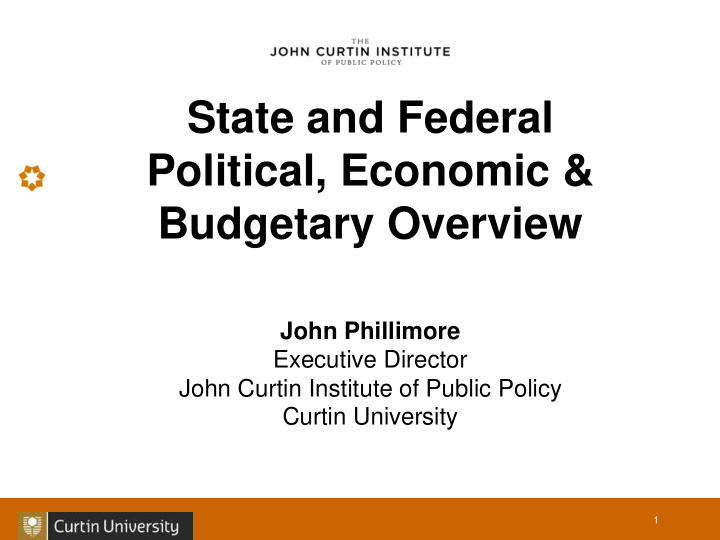



State and Federal Political, Economic & Budgetary Overview John Phillimore Executive Director John Curtin Institute of Public Policy Curtin University 1
Federal & WA Politics: similarities 1. Liberal-National governments 2. More than a third of the way into their term 3. Solid majorities in Lower House 4. Minority in Upper House 5. Budget problems 6. Broken promises 7. Polling problems 8. BUT Labor not really capitalising 2
WA voting intentions (Newspoll) Wednesday, 5 November 2014 3
WA 2PP voting intentions (Newspoll)
Federal voting intentions (Newspoll)
Federal 2PP voting intentions (Newspoll)
Federal & WA Politics: differences Federal Government silver lining 1 st term - - National security & foreign affairs But WA Government has some advantages: - Still has 2.5 years to go - Has a much bigger electoral buffer Leg Council ≠ Senate - 7
Reform Malaise? Paul Kelly ( The Australian ); Ross Garnaut • 1983-2000: the reforming years • Post-2000: policy stagnation & failures, opposition to reform Obstacles: - Organised interests - Loss of bipartisanship - Media - Implementation failures - Loss of government and party capacity, authority, trust - Public expectations, ‘no losers’ veto - Complacency Examples: - Local govt, shopping hours (WA); carbon & mining taxes, GST (Fed) 8
‘Salad Days’: 2000 - 2013 Australia – an international standout: • 22 years uninterrupted growth • Rising incomes and wealth • Low unemployment, high job growth • Low levels of public debt • Came through Asian crisis (1997-8), tech wreck (1999-2000), GFC (2008) Based on: • Record terms of trade (commodity prices) • China boom • Massive mining investment • Legacy of market reforms, strong institutions, policy innovation 9
Real GDP growth, 1990 to 2013
Growth in incomes across the board Source: Bankwest Curtin Economics Centre, Curtin University
Average weekly ordinary time earnings, 1990 to 2013
TERMS OF TRADE Source: Reserve Bank of Australia
Australian Dollar Soars Source: fxtop.com Wednesday, 5 November 2014 17
Resources boom, phase 1: Prices (iron ore $/t) 180 160 140 120 100 80 60 40 20 0 Apr-01 Sep-01 Apr-11 Sep-11 Mar-99 Aug-99 Feb-02 Jul-02 Dec-02 May-03 Oct-03 Mar-04 Aug-04 Jan-05 Jun-05 Nov-05 Apr-06 Sep-06 Feb-07 Jul-07 Dec-07 Mar-09 Aug-09 Feb-12 Jul-12 Dec-12 May-13 Jan-00 Jun-00 Nov-00 May-08 Oct-08 Jan-10 Jun-10 Nov-10 Source: Bureau of Resources and Energy Economics
Resources Boom, Phase 2: Investment Source: Reserve Bank of Australia
‘Dog Days’ ahead? 1. World economy – looking shaky 2. Security fears – IS, Ukraine, Ebola 3. Resources – moving to production phase 4. Lower commodity prices 5. ‘Dutch disease’ – impact of high dollar 6. High cost base 7. Climate change 8. Budget problems 9. Employment and growth slowing 10. Soft or hard landing? 21
WA Fiscal Situation 1. Key issues i. Loss of Triple A credit rating ii. Falling and volatile revenues – GST, royalties (lower iron ore prices), Commonwealth grants iii. Increased debt iv. Controlling expenses growth 2. Strategy i. Privatisation ii. Controlling expenditure (wages, capital investment) iii. Renewed focus on GST issue 22
Source: WA Department of Treasury
Wednesday, 5 November 2014 25
Wednesday, 5 November 2014 26
Wednesday, 5 November 2014 27
Source: WA Department Of Treasury
Source: WA Department Of Treasury
Resources Boom, phase 3: Production Wednesday, 5 November 2014 30
Iron Ore Price Wednesday, 5 November 2014 31
Federal Focus 1. ‘Crisis, what crisis?’: BAU vs. ‘Budget emergency’ 2. Budget issue is real: Hockey, Garnaut, Grattan, PBO i. Revenue base has not recovered ii. Expenses growing iii. Legacy commitments – NDIS, schools iv. New policy commitments – defence, PPL, Direct Action v. Productivity weak 3. Equity and fairness 1. Budget initiatives 2. A revenue or an expenditure problem – or both? 3. Future focus: benefits (yes) vs. tax expenditures (no) 32
Federal Budget Trends Source: Grattan Institute Wednesday, 5 November 2014 35
Long-term budget challenge Wednesday, 5 November 2014 36
Implications for Community Sector 1. Money will remain tight even as disadvantage increases 2. WA Government will try to retain sector’s support 3. Federal Government targeting benefits / entitlements i. Work focus, mutual obligation ii. Simplification of benefits iii. Eligibility tightening iv. Inquiries: McClure, Forrest, Childcare (PC), Empl services v. Use of NFPs for service delivery 4. Andrews agenda remains: pro-family, deregulation 5. Federalism White Paper: i. Linked to tax reform White Paper ii. Issues papers: health, education, housing & homelessness, finances 37
Recommend
More recommend